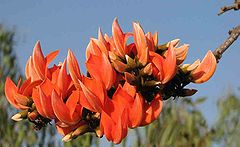Butea monosperma
| Butea monosperma subsp. var. | Kingshuk, Palash, Dhak, Flame of the Forest, Bastard Teak, Parrot Tree | |||||||||||||||||||||||||||||||||||||||||||||||||||||||
|---|---|---|---|---|---|---|---|---|---|---|---|---|---|---|---|---|---|---|---|---|---|---|---|---|---|---|---|---|---|---|---|---|---|---|---|---|---|---|---|---|---|---|---|---|---|---|---|---|---|---|---|---|---|---|---|---|

|
|
| ||||||||||||||||||||||||||||||||||||||||||||||||||||||
| ||||||||||||||||||||||||||||||||||||||||||||||||||||||||
Butea monosperma is a species of Butea native to tropical southern Asia, from Pakistan, India, Bangladesh, Nepal, Sri Lanka, Myanmar, Thailand, Laos, Cambodia, Vietnam, Malaysia, and western Indonesia.[1] Common names include Kingshuk, Palash, Dhak, Flame of the Forest, Bastard Teak, Parrot Tree and Kesudo (Gujurati).
It is a medium sized dry season-deciduous tree, growing to 15 m tall. The leaves are pinnate, with an 8-16 cm petiole and three leaflets, each leaflet 10-20 cm long. The flowers are 2.5 cm long, bright orange-red, and produced in racemes up to 15 cm long. The fruit is a pod 15-20 cm long and 4-5 cm broad.[2]
| Standard Cyclopedia of Horticulture |
|---|
|
Butea frondosa, Roxbg. A leafy tree, yielding gum or lac: Lfts. 3, roundish, pubescent beneath, the lateral ones unsyrametricaJ : fls. 2 in. long, orange-crimson, very showy; stamens 9 together and 1 free. E. India and Burma.—Reaches a height of 50 ft. Inspissated juice is known as Bengal or Palas kino, or butea gum, which has astringent properties, resembling true kind. Seeds used in India as a vermlfuge. The tree yields also stick-lac. The coarse, fibrous material obtained from the inner bark is used for caulking the seams of boats. Dried fls. yield a yellow or orange dye.
|
Cultivation
Propagation
Pests and diseases
Varieties
Gallery
a flower in Kolkata, West Bengal, India.
trunk in Kolkata, West Bengal, India.
trunk in Kolkata, West Bengal, India.
leaves in Kolkata, West Bengal, India.
leaf in Kolkata, West Bengal, India.
flowers on ground in Kolkata, West Bengal, India.
flowers in Kolkata, West Bengal, India.
flowers in Kolkata, West Bengal, India.
flowering tree in Kolkata, West Bengal, India.It is a flowering-plant.
young leaves in Shamirpet, Rangareddy district, Andhra Pradesh, India.
young leaves in Shamirpet, Rangareddy district, Andhra Pradesh, India.
References
- ↑ Cite error: Invalid
<ref>tag; no text was provided for refs namedGRIN - ↑ Huxley, A., ed. (1992). New RHS Dictionary of Gardening. Macmillan ISBN 0-333-47494-5.
- Standard Cyclopedia of Horticulture, by L. H. Bailey, MacMillan Co., 1963
External links
- w:Butea monosperma. Some of the material on this page may be from Wikipedia, under the Creative Commons license.
- Butea monosperma QR Code (Size 50, 100, 200, 500)











